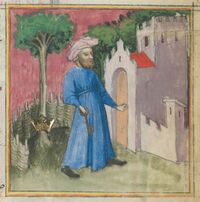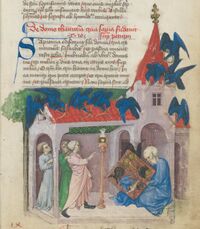ابن أميل
محمد بن أميل التميمي، المعروف في اللاتينية بإسم زاديث الكبير، كان من أوائل المسلمين الكيميائين عاش من ح. 900 إلى ح. 960 م.
لا يُعرف سوى القليل جدًا عن حياته.[2] يدرج كتالوج مكتبة الفاتيكان مخطوطة واحدة تحمل نسبة الأندلسي،[3] مما يشير إلى وجود صلة بإسبانيا الإسلامية، لكن كتاباته تشير إلى أنه عاش وعمل في مصر في الغالب. كما زار شمال أفريقيا والعراق.[4][5] ويبدو أنه عاش أسلوب حياة انطوائيًا، وهو ما أوصى به الآخرين في كتاباته.[6][7]
تشير التصريحات الواردة في كتاباته، التي تقارن الفرن الكيميائي بالمعابد المصرية، إلى أنه ربما عاش لبعض الوقت في أخميم، المركز السابق للكيمياء. كما نقل عن الخيميائيين الذين عاشوا في مصر: زوسيموس البانوبوليس وذو النون المصري.[7]
في الأدب الأوروبي اللاحق، أصبح ابن أميل معروفًا بعدد من الأسماء: لقبه الشيخ أصبح "كبيرًا" عن طريق الترجمة إلى اللاتينية، والصادق الذي تم تحويله صوتيًا إلى "زاديث".[8] و"ابن أوميل" أصبح عن طريق الترجمة الخاطئة "فيليوس حموئيل" أو "بن حموئيل" أو "حمويليس".
القيمة التاريخية
| جزء من سلسلة مقالات عن |
|---|
|
الديانة الهرمسية الأساطير Hermetica ثلاث أجزاء من حكمة الكون الشامل الحركات الهرمسية Orders مواضيع في الهرمسية |
كانت "المياه الفضية" ذات قيمة خاصة لستابلتون،[5] ولويس، وشيروود تايلور، اللذين أظهرا أن بعض أقوال هيرميس لأميل عن هيرميس جاءت من أصول يونانية. وكذلك اقتباساته العديدة من مؤلفين كيميائيين سابقين[2] سمح، على سبيل المثال، لستابلتون بإثبات أن فلاسفة التربة أصلهم عربي،[2] وقام بليسنر بتأريخ "حشد الفلاسفة" إلى كاليفورنيا. 900 م[9]
تحتوي أعمال ابن أميل على تعليق مبكر على لوح الزمرد (نص قصير ومدمج منسوب إلى هرمس الهرامسة)، بالإضافة إلى عدد من الأجزاء الهرمسية الأخرى .[10]
الخيميائي الرمزي
كان ابن أميل كيميائي روحاني ورمزي. لقد رأى نفسه يتبع "أسلافه من حكماء الإسلام" في رفض الكيميائيين الذين يأخذون موضوعهم حرفيًا. وعلى الرغم من أن هؤلاء المجربين اكتشفوا علوم المعادن والكيمياء، إلا أن ابن أميل شعر أن المعنى الرمزي للكيمياء هو الهدف الثمين الذي يتم التغاضي عنه بشكل مأساوي. كتب:
“ولا يستخدم البيض إلا للتشبيه... وقد ألف الفلاسفة كتباً كثيرة في أشياء مثل البيض والشعر والصفراء واللبن والمني والمخالب والملح والكبريت والحديد والنحاس والفضة والزئبق والذهب وكل شيء. "الحيوانات والنباتات المختلفة... ولكن بعد ذلك كان الناس ينسخون هذه الكتب ويتداولونها على ظاهر هذه الأشياء، فيضيعون أموالهم ويفسدون نفوسهم" "اللؤلؤة النقية" باب. 1.[4]
علاوة على ذلك، فقد ألف كتابًا في شرح الرموز، حيث أكد على أن الحكماء يتحدثون "لغة في الرموز" وأنهم "لن يكشفوا [سر الحجر] إلا بالرموز".[11] ويقدم في هذا الكتاب قائمة ضخمة بأسماء الحجر والماء وغيرهما. وبالتالي يشير إلى الغموض الداخلي أو التجربة الدينية للفرد، والتي - على عكس القصة الرمزية - لا يمكن تفسيرها بالكامل.[12][13]
على الرغم من إخلاصه للخيمياء اليونانية، كتب ابن أميل باعتباره مسلم، وكثيرًا ما يذكر دينه، ويشرح أفكاره "لجميع إخواننا المسلمين المتدينين" ويقتبس آيات من القرآن.[4]
المفسر
قدم ابن أميل نفسه كمترجم للرموز الغامضة. وضع أطروحته "الماء الفضي" في معبد مصري "سدر وأبو صير" سجن ياسوف، حيث تعلم يوسف كيفية تفسير أحلام الفرعون. (القرآن: 12 يوسف والتكوين: 4)
"... لم يستطع أحد من هؤلاء المشهورين بحكمتهم أن يشرح كلمة واحدة مما قاله الفلاسفة. في كتبهم يستمرون فقط في استخدام نفس المصطلحات التي نجدها عند الحكماء.... ما هو ضروري، إذا كنت فإني حكيم كشفت له الأسرار، وإذا علمت معاني الرموز فلأشرح أسرار الحكماء».[5]
يمكن اعتبار كتاب ابن أميل "كتاب شرح الرموز (حل الرموز)" بمثابة تلخيص لكتابه "المياه الفضية والأرض المرصعة بالنجوم"، حيث يقدم "توليفة موحدة لأعمال ابن أميل السابقة".[7]
التفسيرات النفسية الحديثة
أدرك عالم النفس CG Jung في قصة ابن أميل القدرة على جلب تحقيق الذات إلى الروح من خلال تفسير الأحلام، ومن الأربعينيات فصاعدًا ركز عمله على الكيمياء. استمرارًا لنهج CG Jung تجاه الخيمياء، يذكر عالم النفس تيودور أبت أن كتاب ابن أميل عن الماء الفضي والأرض المرصعة بالنجوم يقدم وصفًا لعملية التقطير، والتي يُقصد بها أن تكون صورة لعملية "مستمرة". "التأمل في الرموز المختلفة"، وبالتالي خلق الوعي (الذي يرمز إليه بـ "الضوء"، و"الذهب") من واقع المادة والطبيعة والجسد ("الأرض المرصعة بالنجوم"). وهذا يدل على أن "العملية الخيميائية هي في الواقع عمل نفسي بالكامل يقوم على التعامل مع المادة الملموسة والواقع الجسدي".[5] [7]
أعمال منسوبة لابن أميل
- Ḥall ar-Rumūz (Solving the Riddles/Book of Explanation of the Symbols)[7]
- ad-Durra an-Naqīya (The Pure Pearl)
- Kitāb al-Maghnisīya (The Book of Magnesia)
- Kitāb Mafātīḥ al-Ḥikma al-‘Uẓmā (The Book of the Keys of the Greatest Wisdom)
- al-Mā’ al-Waraqî wa'l-Arḍ an-Najmīya (The Silvery Water and the Starry Earth) that comprises a narrative; a poem Risālat ash-Shams ilā al-Hilâl (Epistola solis ad lunam crescentem, the letter of the Sun to the Crescent Moon),[14][15]
- Al-Qasida Nuniya (Poem rhyming on the Letter Nun), with a commentary by Ibn Umail. Ms. Beşir Ağa (Istanbul) 505. For the poem without commentary see Stapelton's Three Arabic Treatises[5]
- Al-Qasida al-mīmīya (Poem rhyming on the Letter Mīm), with a commentary by Ibn Umail[16]
منشورات لاحقة
- 12th century: al-Mā’ al-Waraqī (Silvery Water) became a classic of Islamic Alchemy. It was translated into Latin in the twelfth or thirteenth century and was widely disseminated among alchemists in Europe often called Senioris Zadith tabula chymica (The Chemical Tables of Senior Zadith)[14]
- 1339: In the al-Mâ’ al-Waraqī transcript that is now in Topkapi Palace Library, Istanbul, the scribe added a note to the diagram that the sun represents the spirit (al-rūḥ) and the moon the soul (al-nafs) so the "Letter from the Sun to the Moon" is about perfecting the receptivity of soul to spirit.[14]
- 14th century: Chaucer's Canon's Yeoman's Tale has alchemy as a theme and cites Chimica Senioris Zadith Tabula (The Chemical Tables of Senior Zadith). Chaucer considered Ibn Umayl to be a follower of Plato.
- 15th century: Aurora consurgens is a commentary by Pseudo Aquinas on a Latin translation of Al-mâ' al-waraqî (Silvery Water).
- 1605 Senioris Zadith filii Hamuelis tabula chymica (The Chemical Tables of Senior Zadith son of Hamuel) was printed as part I of Philosophiae Chymicae IV. Vetvstissima Scripta by Joannes Saur[17]
- 1660: The Chemical Tables of Senior Zadith retitled Senioris antiquissimi philosophi libellus was printed in volume 5 of the Theatrum chemicum.
- 1933 Three Arabic treatises on alchemy by Muhammad bin Umail (10th century AD), prints the three treatises in Arabic, and prints them in 13th century Latin as they were partially translated from the Arabic to Latin in 13th century. Printed in the journal Memoirs of the Asiatic Society of Bengal, Volume 12, Calcutta.[5]
- 1997/2006: Corpus Alchemicum Arabicum 1A: An improved translation of Book of the Explanation of the Symbols. Kitāb Ḥall ar-Rumūz with a commentary by the Jungian psychologist and scholar Marie-Louise von Franz.[12]
معرض صور
تم تصوير ابن عميل في الكتب الأوروبية اللاحقة. في ارتفاع الشفق، ج.1400، هنا يحمل زاديث الكبير المفتاح الذي يفتح بيت كنز الحكمة.
المراجع
- ^ Abt, Theodor (2009). Book of the Explanation of the Symbols. Kitāb Hal ar-Rumūz. Psychological commentary by Theodor. Corpus Alchemicum Arabicum (CALA) IB. Zurich: Living Human Heritage Publications. ISBN 978-3952260883.
- ^ أ ب ت Holmyard, E.J. (1990) [1957]. Alchemy (reprint ed.). New York: Dover. ISBN 0486262987.
- ^ Paul Kraus: Jâbir ibn Haiyân, Cairo, IFAO, 1942–3, p. 299.
- ^ أ ب ت Starr, Peter: Towards a Context for Ibn Umayl, Known to Chaucer as the Alchemist Senior. Retrieved 2024-05-06
- ^ أ ب ت ث ج ح Turāb ʿAlī, M.; Stapleton, H. E.; Hidāyat Ḥusain, M. (1933). "Three Arabic Treatises on Alchemy by Muḥammad bin Umail (10th century A.D.)". Memoirs of the Asiatic Society of Bengal. 12 (1): 1–213. OCLC 29062383. This seminal work was reprinted in facsimile in 2002 as Ibn Umayl (fl. c. 912). Texts and Studies (Collection "Natural Science in Islam" Archived 2011-05-27 at the Wayback Machine, vols. nº 55-75). Ed. F. Sezgin. ISBN 3-8298-7081-7. Published by Institut für Geschichte der Arabisch-Islamischen Wissenschaften Archived 2011-05-27 at the Wayback Machine, University of Frankfurt, Westendstrasse 89 , D-60325 Frankfurt am Main.
- ^ Ibn Umayl, Mohammad. Ad-Durra an-naqīya Ms No. 1410. Hyderabad: Asaf. lib.fol. 2f.
- ^ أ ب ت ث ج Abt, Theodor; Madelung, Wilferd; Hofmeier, Thomas (2003). Book of the Explanation of the Symbols. Kitāb Ḥall ar-Rumūz by Muḥammad ibn Umail. Corpus Alchemicum Arabicum (CALA) I. Translated by Salwa Fuad and Theodor Abt. Zurich: Living Human Heritage Publications.p. XIII.
- ^ Julius Ruska, Senior Zadith = Ibn Umail. Orientalistische Literaturzeitung 31, 1928, pp. 665-666.
- ^ Martin Plessner, The Place of the Turba Philosophorum in the Development of Alchemy. ISIS, Vol. 45, No. 4, Dec. 1954, pp. 331-338
- ^ Stapleton, H. E.; Lewis, G. L.; Taylor, F. Sherwood (1949). "The sayings of Hermes quoted in the Māʾ al-waraqī of Ibn Umail". Ambix. 3 (3–4): 69–90. doi:10.1179/amb.1949.3.3-4.69. p. 81, et passim.
- ^ Mohammed ibn Umail: Book of the Explanation of the Symbols - Kitab Hall ar-Rumuz, edited by Th. Abt and W. Madelung, Corpus Alchemicum Arabicum (CALA) 1, Zurich 2003, p. 3.8; see also: p. 5.20 ("symbols of sages"), p. 145.2 ("reveal it except with symbols"), p. 151.3 ("dog as symbol").
- ^ أ ب von Franz, Marie-Louise (2006). Theodor Abt (ed.). Book of the Explanation of the Symbols. Kitāb Ḥall ar-Rumūz by Muḥammad ibn Umail. Psychological commentary by Marie-Louise von Franz. Corpus Alchemicum Arabicum (CALA) IA. Zurich: Living Human Heritage Publications. pp. 11, 15, 26–7. ISBN 3952260835.
- ^ An allegory can be replaced by one word or one phrase and thus be sufficiently explained. See about this discrimination: Theodor Abt, Psychological Commentary on Ibn Umails "Book of the Explanation of the Symbols - Kitab Hall ar-Rumuz", Corpus Alchemicum Arabicum (CALA 1B), Zurich 2009, p. 67-71.
- ^ أ ب ت Berlekamp, Persis (2003). Murqarnas Volume 20: Painting as Persuasion, a visual defense of alchemy in an Islamic manuscript of the Mongol period. Leiden, Netherlands: Koninklijke Brill NV. ISBN 9004132074.
- ^ Julius Ruska, Studien zu Muhammad Ibn Umail al-Tamimi's Kitab al-Ma' al-Waraqi wa'l-Ard an-Najmiyah, Isis, Vol. 24, No. 2 (Feb., 1936), pp. 310-342.
- ^ Ms. Beşir Ağa (Istanbul) 505.
- ^ Dickinson College Digital Collections Philosophiae Chymicae IV. Vetvstissima Scripta
وصلات خارجية
- Chaucer Name Dictionary 1988, Jacqueline de Weever, Garland Publishing
- (in فرنسية) Commentary on the Bibliotheca Chemica at item 86.
- Millesima, Julia (2011). "ibn Umail-Senior Zadith, Introduction to Tabula Chimica". Alchemy Key Concepts & the Art of Fire. Ancient Authors & Hidden Evidence. Labyrinth Designers. Retrieved 29 August 2013.
- In Arabic. "Three Arabic treatises on alchemy by Muhammad bin Umail (10th century AD): EDITION OF THE TEXTS"[dead link], published in Memoirs of the Asiatic Society of Bengal Volume 12, year 1933.
- Short description is different from Wikidata
- Incomplete lists
- Articles with فرنسية-language sources (fr)
- Articles with dead external links from August 2024
- مواليد عقد 900
- وفيات 960
- عرب القرن العاشر
- Alchemists of the medieval Islamic world
- 10th-century scholars
- 10th-century philosophers
- Islamic philosophers
- Philosophers of the medieval Islamic world



